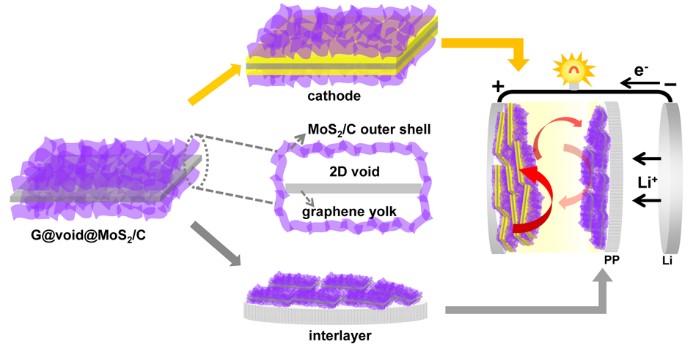Y. F. Dong, P. F. Lu, H. D. Shi, J. Q. Qin, J. Chen, W. C. Ren, H.-M. Cheng, Z.-S. Wu*
Journal of Energy Chemistry, 2019, 36: 64-73.
DOI: 10.1016/j.jechem.2019.04.023 [PDF]
Invited Paper for JEC DICP s 70 anniversary Special Issue

Lithium sulfur (Li-S) batteries hold great promising for high-energy-density batteries, but appear rapid capacity fading due to the lack of overall and elaborated design of both sulfur host and interlayer. Herein, we developed a novel two-dimensional (2D) hierarchical yolk-shell heterostructure, constructed by a graphene yolk, 2D void and outer shell of vertically aligned carbon-mediated MoS2 nanosheets (G@void@MoS2/C), as advanced host-interlayer integrated electrode for Li-S batteries. Notably, the 2D void, with a typical thickness of ~ 80 nm, provided suitable space for loading and confining nano sulfur, and vertically aligned ultrathin MoS2 nanosheets guaranteed enriched catalytically active sites to effectively promote the transition of soluble polysulfides. The conductive graphene yolk and carbon mediated shell sufficiently accelerated electron transport. Therefore, the integrated electrode of G@void@MoS2/C not only exceptionally confined the sulfur/polysulfides in 2D yolk-shell heterostructures, but also achieved catalytic transition of the residual polysulfides dissolved in electrolyte to solid Li2S2/Li2S, both of which synergistically achieved an extremely low capacity fading rate of 0.05% per cycle over 1000 times at 2 C, outperforming most reported Mo based cathodes and interlayers for Li-S batteries. 2D hierarchical yolk-shell heterostructures developed here may shed new insight on elaborated design of integrated electrodes for Li-S batteries. |